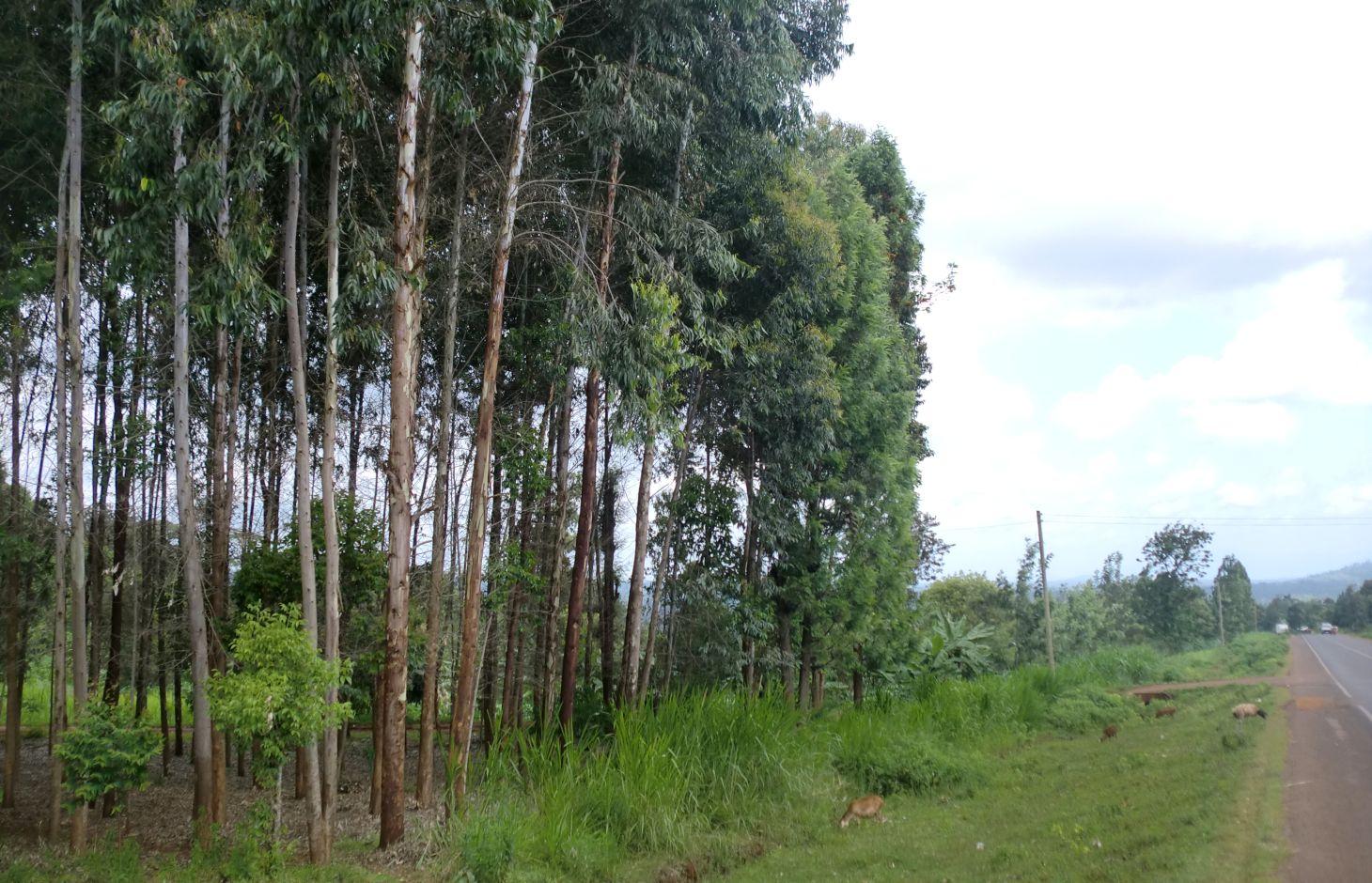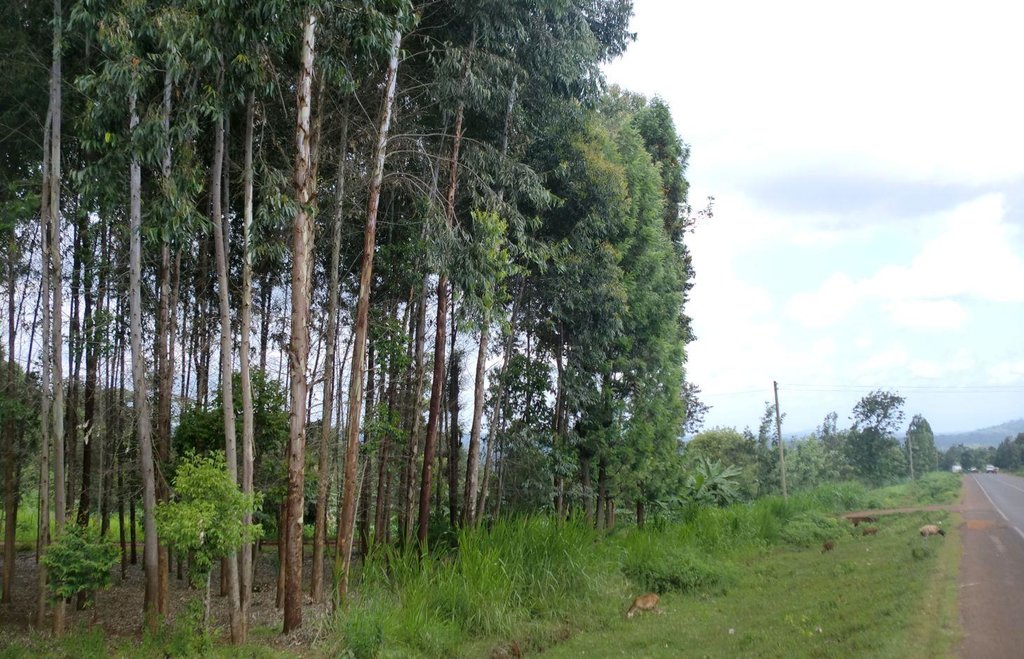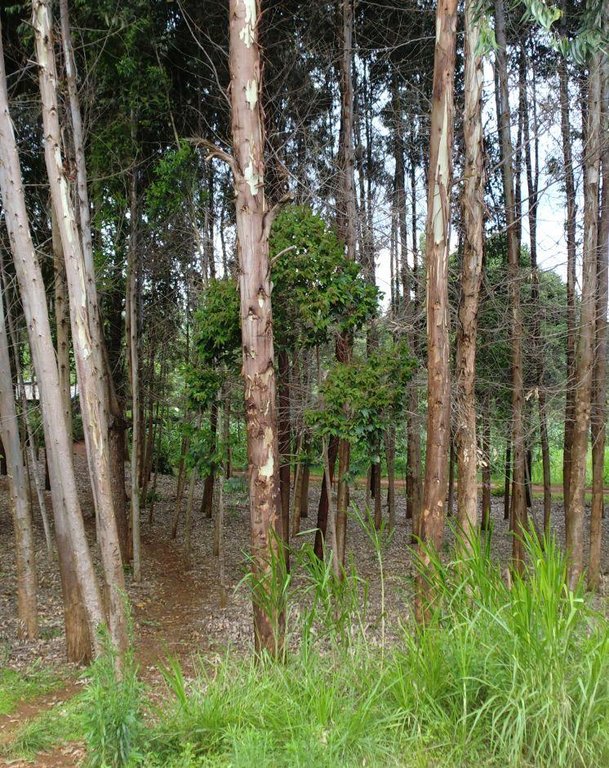Woodlot [肯尼亚]
- 创建:
- 更新:
- 编制者: Paul Kahiga
- 编辑者: –
- 审查者: Fabian Ottiger, Alexandra Gavilano
Mutitu (Kiembu and Mbeere)
technologies_1736 - 肯尼亚
查看章节
全部展开 全部收起1. 一般信息
1.2 参与该技术评估和文件编制的资源人员和机构的联系方式
SLM专业人员:
Gathenya John
Jomo Kenyatta University of Agriculture and Technology
肯尼亚
SLM专业人员:
Home Patrick
Jomo Kenyatta University of Agriculture and Technology
肯尼亚
SLM专业人员:
Wamuongo Jane
Kenya Agricultural Research Institute
肯尼亚
有助于对技术进行记录/评估的机构名称(如相关)
KARI Headquarters (KARI Headquarters) - 肯尼亚有助于对技术进行记录/评估的机构名称(如相关)
Jomo Kenyatta University (Jomo Kenyatta University) - 肯尼亚1.3 关于使用通过WOCAT记录的数据的条件
编制者和关键资源人员接受有关使用通过WOCAT记录数据的条件。:
是
1.4 所述技术的可持续性声明
这里所描述的技术在土地退化方面是否存在问题,导致无法被认为是一种可持续的土地管理技术?:
否
2. SLM技术的说明
2.1 技术简介
技术定义:
This is a vegetative technology that involves planting of trees in a portion of land for various uses.
2.2 技术的详细说明
说明:
Woodlots in both Embu and Mbeere districts and in most parts of rural Kenya are usually small afforested plots of 0.04 to 0.5ha which are usually associated with the local demand for timber and fuel wood. They are mainly established and managed on individual basis. Grevillea Robusta and Eucalyptus trees are the main tree species used for woodlots in Embu District. Fast-growing and coppicing species are best for woodlot establishment.
Purpose of the Technology: Woodlots are mainly used for provision of firewood, timber and building materials. Woodlots also prevent soil erosion through their thick mulch and roots that hold the soil together. Other benefits of woodlots includes provision of cool weather, air purification or windbreakers. They are well protected, especially during the first years after establishment.
Establishment / maintenance activities and inputs: Farmers in Embu district normally obtain healthy plants is by using seedlings from their individual or local nurseries. The nurseries should be set 6-10 weeks before the start of the rainy season. The plants must be transferred to the fields in the early rainy season. The trees can be planted after a shallow ploughing (seeds) or in planting pits (seedlings). Spacing changes according to the purpose, 2 x 2 m or 2 x 4 m are common options. Management should be particularly careful in the first years. Weeding should be carried out 2-3 times in the first 2 years in order to avoid competition with weeds and reduce pests’ infestations. The area must be closed to grazing animals for the first few
years. Woodlots need protection from fire.
Natural / human environment: At early stages of establishment, farmers inter-crop the trees with crops. Percieved poor land that cannot be used for anything but trees is primarily recommended for woodlots. While siting the location of planting woodlot, transport requirements must be borne in mind. The site for timber and wood production for domestic use should preferably be near the house to reduce the burden of carrying firewood
2.3 技术照片
2.5 已应用该技术的、本评估所涵盖的国家/地区/地点
国家:
肯尼亚
区域/州/省:
Eastern Province
有关地点的进一步说明:
Embu District
具体说明该技术的分布:
- 均匀地分布在一个区域
如果不知道精确的区域,请注明大致覆盖的区域:
- < 0.1 平方千米(10 公顷)
注释:
Woodlots in thie Embu North District are implemented on small individual farms
2.6 实施日期
如果不知道确切的年份,请说明大概的日期:
- 10-50年前
2.7 技术介绍
详细说明该技术是如何引入的:
- 通过土地使用者的创新
3. SLM技术的分类
3.1 该技术的主要目的
- 改良生产
- 减少、预防、恢复土地退化
- 创造有益的经济影响
3.2 应用该技术的当前土地利用类型
同一土地单元内混合使用的土地::
是
具体说明混合土地使用(作物/放牧/树木):
- 农林业

农田
- 一年一作
- 乔木与灌木的种植
年作 - 具体指明作物:
- 谷物类 - 玉米
乔木和灌木种植 - 指定作物:
- 咖啡,采树荫栽培
具体说明:
Longest growing period in days: 1500, Longest growing period from month to month: five years

森林/林地
树木类型:
- 桉树树种
- 银桦
产品和服务:
- 木材
- 薪材
注释:
Major land use problems (compiler’s opinion): Soil erosion
Major land use problems (land users’ perception): firewood
3.4 供水
该技术所应用土地的供水:
- 雨养
3.5 该技术所属的SLM组
- 天然和半天然森林管理
- 防风林/防护林带
- 改良的地面/植被覆盖
3.6 包含该技术的可持续土地管理措施

植物措施
- V1:乔木和灌木覆盖层
注释:
Type of vegetative measures: aligned: -contour
3.7 该技术强调的主要土地退化类型

生物性退化
- Bc:植被覆盖的减少
注释:
Main causes of degradation: deforestation / removal of natural vegetation (incl. forest fires), population pressure
3.8 防止、减少或恢复土地退化
具体数量名该技术与土地退化有关的目标:
- 防止土地退化
4. 技术规范、实施活动、投入和成本
4.1 该技术的技术图纸
技术规范(与技术图纸相关):
The technical drawing on the left shows a stand of woodlot with natural vegetation growing underneath. The woodlot mainly comprises of Eucalyptus and Grevillea Robusta trees for fire wood and timber production.
Location: Embu North District. Eastern province
Date: 02.09.2011
Technical knowledge required for land users: moderate
Main technical functions: stabilisation of soil (eg by tree roots against land slides)
Secondary technical functions: control of raindrop splash, improvement of ground cover
Aligned: -contour
Vegetative material: T : trees / shrubs
Number of plants per (ha): 500
Vertical interval between rows / strips / blocks (m): 2
Spacing between rows / strips / blocks (m): 2
Vertical interval within rows / strips / blocks (m): 2
Width within rows / strips / blocks (m): 2
In blocks
Vegetative material: T : trees / shrubs
作者:
Paul Kahiga, 62000-00200 Nairobi
4.2 有关投入和成本计算的一般信息
其它/国家货币(具体说明):
Kshs
如相关,注明美元与当地货币的汇率(例如1美元=79.9巴西雷亚尔):1美元=:
100.0
注明雇用劳工的每日平均工资成本:
4.00
4.3 技术建立活动
| 活动 | 时间(季度) | |
|---|---|---|
| 1. | Seeding | before the rainy season |
| 2. | Transplanting | Onset of the rainy season |
4.4 技术建立所需要的费用和投入
| 对投入进行具体说明 | 单位 | 数量 | 单位成本 | 每项投入的总成本 | 土地使用者承担的成本% | |
|---|---|---|---|---|---|---|
| 劳动力 | Transplanting | Mandays | 4.0 | 1.0 | 4.0 | 100.0 |
| 设备 | Tools | ha | 1.0 | 5.0 | 5.0 | 100.0 |
| 植物材料 | Seeds | Grams | 100.0 | 0.05 | 5.0 | 100.0 |
| 技术建立所需总成本 | 14.0 | |||||
| 技术建立总成本,美元 | 0.14 | |||||
注释:
Duration of establishment phase: 2 month(s)
4.5 维护/经常性活动
| 活动 | 时间/频率 | |
|---|---|---|
| 1. | Weeding | 2-3 times for the first three years |
| 2. | Prunning | once per year |
4.6 维护/经常性活动所需要的费用和投入(每年)
| 对投入进行具体说明 | 单位 | 数量 | 单位成本 | 每项投入的总成本 | 土地使用者承担的成本% | |
|---|---|---|---|---|---|---|
| 劳动力 | Weeding | mandays | 10.0 | 0.4 | 4.0 | 100.0 |
| 劳动力 | Prunning | mandays | 10.0 | 0.4 | 4.0 | 100.0 |
| 设备 | Tools | ha | 1.0 | 5.0 | 5.0 | 100.0 |
| 技术维护所需总成本 | 13.0 | |||||
| 技术维护总成本,美元 | 0.13 | |||||
4.7 影响成本的最重要因素
描述影响成本的最决定性因素:
Labor and the cost of seedlings are the most determinate factors affecting the costs.
5. 自然和人文环境
5.1 气候
年降雨量
- < 250毫米
- 251-500毫米
- 501-750毫米
- 751-1,000毫米
- 1,001-1,500毫米
- 1,501-2,000毫米
- 2,001-3,000毫米
- 3,001-4,000毫米
- > 4,000毫米
农业气候带
- 潮湿的
- 半湿润
Thermal climate class: tropics
5.2 地形
平均坡度:
- 水平(0-2%)
- 缓降(3-5%)
- 平缓(6-10%)
- 滚坡(11-15%)
- 崎岖(16-30%)
- 陡峭(31-60%)
- 非常陡峭(>60%)
地形:
- 高原/平原
- 山脊
- 山坡
- 山地斜坡
- 麓坡
- 谷底
垂直分布带:
- 0-100 m a.s.l.
- 101-500 m a.s.l.
- 501-1,000 m a.s.l.
- 1,001-1,500 m a.s.l.
- 1,501-2,000 m a.s.l.
- 2,001-2,500 m a.s.l.
- 2,501-3,000 m a.s.l.
- 3,001-4,000 m a.s.l.
- > 4,000 m a.s.l.
5.3 土壤
平均土层深度:
- 非常浅(0-20厘米)
- 浅(21-50厘米)
- 中等深度(51-80厘米)
- 深(81-120厘米)
- 非常深(> 120厘米)
土壤质地(表土):
- 中粒(壤土、粉土)
表土有机质:
- 中(1-3%)
如有可能,附上完整的土壤描述或具体说明可用的信息,例如土壤类型、土壤酸碱度、阳离子交换能力、氮、盐度等。:
Soil fertility: Medium
Soil drainage/infiltration: Good
Soil water storage capacity: Medium
5.4 水资源可用性和质量
地下水位表:
5-50米
地表水的可用性:
好
水质(未处理):
良好饮用水
5.5 生物多样性
物种多样性:
- 中等
5.6 应用该技术的土地使用者的特征
生产系统的市场定位:
- 混合(生计/商业)
非农收入:
- 低于全部收入的10%
相对财富水平:
- 平均水平
个人或集体:
- 个人/家庭
机械化水平:
- 手工作业
性别:
- 女人
- 男人
说明土地使用者的其他有关特征:
Land users applying the Technology are mainly common / average land users
Population density: 10-50 persons/km2
Annual population growth: 0.5% - 1%
5.7 应用该技术的土地使用者使用的平均土地面积
- < 0.5 公顷
- 0.5-1 公顷
- 1-2 公顷
- 2-5公顷
- 5-15公顷
- 15-50公顷
- 50-100公顷
- 100-500公顷
- 500-1,000公顷
- 1,000-10,000公顷
- > 10,000公顷
这被认为是小规模、中规模还是大规模的(参照当地实际情况)?:
- 小规模的
5.8 土地所有权、土地使用权和水使用权
土地所有权:
- 个人,有命名
土地使用权:
- 个人
用水权:
- 个人
5.9 进入服务和基础设施的通道
健康:
- 贫瘠
- 适度的
- 好
教育:
- 贫瘠
- 适度的
- 好
6. 影响和结论性说明
6.1 该技术的现场影响
社会经济效应
生产
作物生产
饲料生产
木材生产
产品多样性
收入和成本
农业收入
社会文化影响
食品安全/自给自足
Improved livelihoods and human well-being
注释/具体说明:
Fire wood and timber is used for building houses
生态影响
水循环/径流
地表径流
地下水位/含水层
减少气候和灾害风险
风速
6.2 该技术的场外影响已经显现
风力搬运沉积物
6.4 成本效益分析
技术收益与技术建立成本相比如何(从土地使用者的角度看)?
短期回报:
积极
长期回报:
积极
技术收益与技术维护成本/经常性成本相比如何(从土地使用者的角度看)?
短期回报:
积极
长期回报:
积极
6.5 技术采用
在所有采用这项技术的人当中,有多少人是自发的,即未获得任何物质奖励/付款?:
- 91-100%
注释:
100% of land user families have adopted the Technology without any external material support
There is a moderate trend towards spontaneous adoption of the Technology
6.7 该技术的优点/长处/机会
| 编制者或其他关键资源人员认为的长处/优势/机会 |
|---|
| Production of timber and firewood. |
| Woodlots acts as windbreaks |
6.8 技术的弱点/缺点/风险及其克服方法
| 编制者或其他关键资源人员认为的弱点/缺点/风险 | 如何克服它们? |
|---|---|
| Occupies land that could otherwise be utilized for food crops | Plant the trees along the boundaries. |
7. 参考和链接
7.1 信息的方法/来源
- 实地考察、实地调查
- 与土地使用者的访谈
(现场)数据是什么时候汇编的?:
06/03/2012
链接和模块
全部展开 全部收起链接
无链接
模块
无模块




